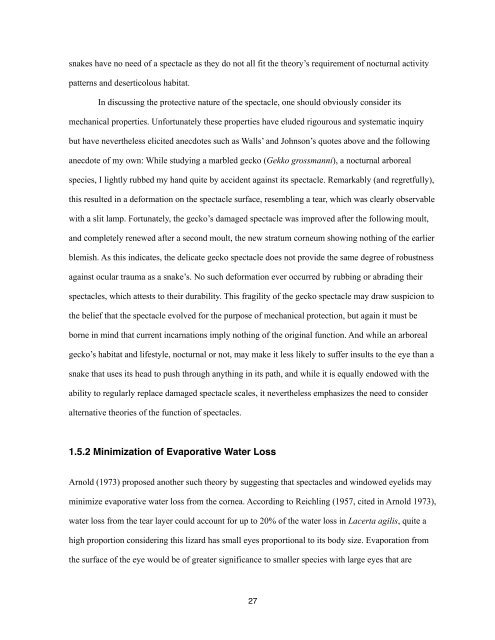Chapter 1, The Reptilian Spectacle - UWSpace - University of ...
Chapter 1, The Reptilian Spectacle - UWSpace - University of ...
Chapter 1, The Reptilian Spectacle - UWSpace - University of ...
You also want an ePaper? Increase the reach of your titles
YUMPU automatically turns print PDFs into web optimized ePapers that Google loves.
snakes have no need <strong>of</strong> a spectacle as they do not all fit the theory’s requirement <strong>of</strong> nocturnal activity<br />
patterns and deserticolous habitat.<br />
In discussing the protective nature <strong>of</strong> the spectacle, one should obviously consider its<br />
mechanical properties. Unfortunately these properties have eluded rigourous and systematic inquiry<br />
but have nevertheless elicited anecdotes such as Walls’ and Johnson’s quotes above and the following<br />
anecdote <strong>of</strong> my own: While studying a marbled gecko (Gekko grossmanni), a nocturnal arboreal<br />
species, I lightly rubbed my hand quite by accident against its spectacle. Remarkably (and regretfully),<br />
this resulted in a deformation on the spectacle surface, resembling a tear, which was clearly observable<br />
with a slit lamp. Fortunately, the gecko’s damaged spectacle was improved after the following moult,<br />
and completely renewed after a second moult, the new stratum corneum showing nothing <strong>of</strong> the earlier<br />
blemish. As this indicates, the delicate gecko spectacle does not provide the same degree <strong>of</strong> robustness<br />
against ocular trauma as a snake’s. No such deformation ever occurred by rubbing or abrading their<br />
spectacles, which attests to their durability. This fragility <strong>of</strong> the gecko spectacle may draw suspicion to<br />
the belief that the spectacle evolved for the purpose <strong>of</strong> mechanical protection, but again it must be<br />
borne in mind that current incarnations imply nothing <strong>of</strong> the original function. And while an arboreal<br />
gecko’s habitat and lifestyle, nocturnal or not, may make it less likely to suffer insults to the eye than a<br />
snake that uses its head to push through anything in its path, and while it is equally endowed with the<br />
ability to regularly replace damaged spectacle scales, it nevertheless emphasizes the need to consider<br />
alternative theories <strong>of</strong> the function <strong>of</strong> spectacles.<br />
1.5.2 Minimization <strong>of</strong> Evaporative Water Loss<br />
Arnold (1973) proposed another such theory by suggesting that spectacles and windowed eyelids may<br />
minimize evaporative water loss from the cornea. According to Reichling (1957, cited in Arnold 1973),<br />
water loss from the tear layer could account for up to 20% <strong>of</strong> the water loss in Lacerta agilis, quite a<br />
high proportion considering this lizard has small eyes proportional to its body size. Evaporation from<br />
the surface <strong>of</strong> the eye would be <strong>of</strong> greater significance to smaller species with large eyes that are<br />
27
















